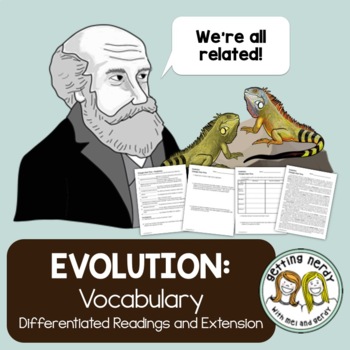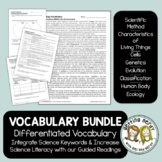Evolution Vocabulary - Differentiated Science Reading Passages & Questions
- Zip
What educators are saying
Also included in
- Science terminology doesn't have to be overwhelming. Each of our integrated literacy activities includes a teacher-written, student-friendly reading that introduces new terminology in a fun and engaging way while providing differentiated options that can be given at the teacher's discretion. The reaPrice $28.50Original Price $34.45Save $5.95
Description
Evolution Vocabulary - Differentiated Life Science Lesson
Learn about Darwin's theory of evolution and how mutation, adaptation, and natural selection lead to survival of the fittest and ultimately evolution in this vocabulary lesson that includes a reading and PowerPoint.
The reading is the same for below and above level readers but offers questions that are differentiated. Students don't even need to know that they are receiving work that is different from their peers as they read about adaptation and evolution.
The Evolution Differentiated Vocabulary Lessons are differentiated for:
* Below level readers: ESOL students or those that require scaffolding and support as the vocabulary terms are bold face in the reading and the questions are simplified with matching or recall activities.
* Above level readers: Honors, challenge or AP students as the vocabulary terms are not in bold, students use graphic organizers, make their own definitions, and answer extension questions which require inference skills.
We have vocabulary sheets for all biology/life science topics:
2. Cells
4. Genetics
5. Evolution
7. Human Body: Medical Prefixes and Suffixes
8. Ecology - a FREE vocabulary lesson that goes along with our Intro to Ecology mini-bundle.
Want them all? Save and buy the Life Science Vocabulary Bundle- ALL Units Differentiated for ALL Readers!
Buy this lesson on its own or GO BIG and buy it in our 2-3 week Evolution Bundled Unit which includes a 100+ PowerPoint slide presentation and 40+ handouts
Consider using this with some of our other products in our store:
- Fortune Teller Life Science Vocabulary Bundle
Click this link to find out how this lesson fits with your NGSS, TEKS or GSE Science Classroom
Getting Nerdy's Terms of Use (TOU):
- Purchase of the product is for single classroom use by the purchaser only. It is a violation for individuals, schools, and districts to redistribute, edit, sell, or post this item on the Internet or to other individuals. Disregarding the copyright is a violation of the Digital Millennium Copyright Act and subject to legal action.
-By purchasing this product you acknowledge that you have read and understood the Terms of Use.
Evolution Vocabulary Differentiated for ALL Readers by © 2014 Getting Nerdy, LLC






